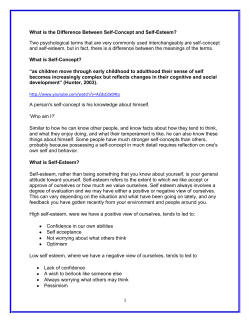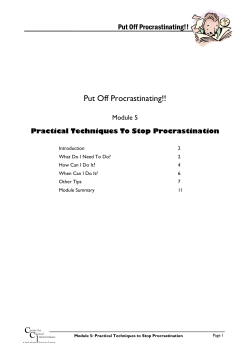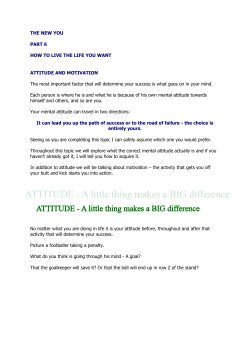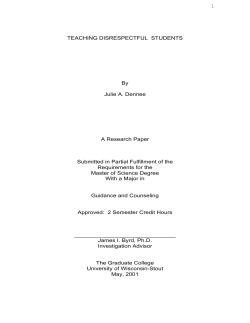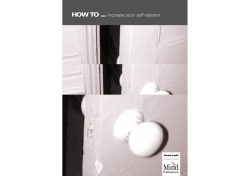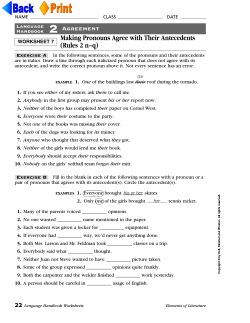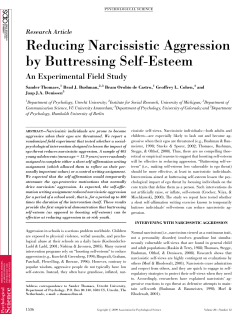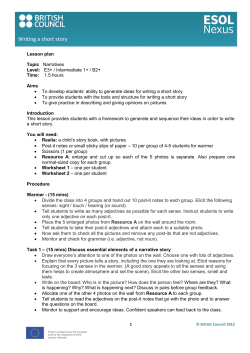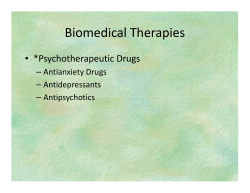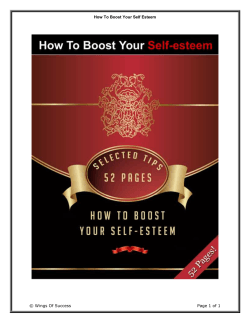
Self-Esteem Improving Improving Self-Esteem Accepting Yourself
Self-Esteem Improving Self-Esteem Improving Improving Self-Esteem Module 6 Accepting Yourself Introduction 2 Focusing On the Positive You 2 Positive Qualities Record 2 ‘Positive You Journal’ 4 Worksheet: Positive Qualities Record 5 Worksheet: Positive You Journal (Past Examples) 6 Worksheet: Positive You Journal (Everyday Examples) 7 Acting Like the Positive You 8 Getting Started 8 Making Changes 8 Starting Simple 9 Worksheet: Weekly Activity Schedule Pleasurable Activities Catalogue Worksheet: Fun & Achievement Activities Schedule C CI entre for linical nterventions • Psychotherapy • Research • Training 10 11 13 Module Summary 14 About This Module 15 Module 6: Accepting Yourself Page 1 Self-Esteem Improving Introduction In the previous module we looked at how to combat negative self-evaluations. Battling against some of the negative things you say to yourself is one path to overcoming low self-esteem. However, another path is to promote balanced evaluations of yourself. This means noticing and acknowledging the positive aspects of yourself, and behaving like someone who has positive qualities and is deserving of happiness and fun. In this module, we will show you exactly how to go about doing these things to boost your self-esteem. Focusing On the Positive You Very quickly, jot down a few of your positive qualities in the space below, and then read on. How easy was it for you to do that? Some people might struggle to bring things to mind. This is because, as we mentioned in earlier modules, when you have low self-esteem, you have a tendency to only pay attention to negative things that confirm your negative view of yourself. You rarely pay attention to the positive things you do, your positive qualities, positive outcomes or positive comments from others. This will make the positive aspects of you very hard to get to at first, because you have not taken any notice of them. Other people might have less trouble recalling positive things about themselves, but instead might feel uncomfortable thinking about, talking about, or writing about the positive qualities they have. They might consider it as being conceited, arrogant, or stuck up to think about such things. If either of these apply to you, you will need to approach this module with an open mind. In this module you will be asked to start noticing the positives in you that you often ignore and acknowledge these positives. Remember, most of the time all you pay attention to are your negative qualities and you feel comfortable dwelling on these negatives. Ask yourself how fair that is. By getting you to begin acknowledging your positives, you are really tipping the scales of self-evaluation back into balance. These scales have been pretty off balance (towards the side of negativity) for some time now. Positive Qualities Record So, where do we start? When we notice something and it’s really important for us to remember it, what is it that we do to help us remember? We write things down, make a note of it, or make a list if there are many items. The same approach applies here. To start acknowledging your positives, you need to write them down. What was your initial reaction to this suggestion of writing a list of your positive attributes? Did you feel any anxiety, shame, uneasiness, sadness, fear? Did you think “What could I possibly write?” “I have nothing worth writing down,” “Me! Positive attributes? Ha!” You need to be careful here, and listen out for negative self-evaluations coming through, and the tendency you may have to discount or minimise anything positive about yourself. Remember that this is a nasty habit that may rear its head when you try to do this exercise. Should this happen, just acknowledge it and try to move on to the task at hand. If the negative self-evaluations simply won’t release their grip on you that easily, then go back to the Thought Diary for Negative Self-Evaluations to help you out. C CI entre for linical nterventions • Psychotherapy • Research • Training Module 6: Accepting Yourself Page 2 Self-Esteem Improving Now, start a ‘Positive Qualities Record.’ Make a list of the positive aspects of yourself, including all your good characteristics, strengths, talents, and achievements, and record them on the worksheet on page 5. You might want to record all of this in a special book or journal – one that is dedicated especially to this task of focusing on your positive qualities. Here are some important tips for getting started: When you are recording something in your Positive You Journal, make sure you set aside a special time to commit to the task and carry it out. Don’t do it on the run, or while you are doing other things, or fit it in around other activities. Instead, give it the due attention and time it deserves. Remember to write them down on the worksheet provided or in your special journal, rather than just making a mental note or writing something on the back of a napkin or scrap of paper. Write your positive qualities in your journal or worksheet so that you remember it and know exactly where to find it. In this way, the positive qualities won’t get lost. Write as many positive things about yourself as you can think of…there is no limit. Exhaust all avenues and brainstorm as many ideas as possible. If you run out of steam, take a break. Come back to it over the course of a few days, until you have a substantial list of your positives. Get help if you feel comfortable to do so. Enlist the help of a trusted friend or family member – someone whom you know would be supportive of you doing this, rather than someone who may be a contributor to your self-esteem problems. Two heads are better than one and an outsider might have a different perspective of you, than you do of yourself. Who knows what nice things you might discover about yourself with their help. As already mentioned, watch out for negative self-evaluations or discounting your positives as “small” or “no big deal” or “not worth writing.” You tend to remember detailed negative things about yourself, therefore we must do the same with the positives – it is only fair! Also remember, you don’t have to do these positive things absolutely perfectly or 100% of the time – that is impossible. So be realistic about what you write down. For example, if you tend to be ‘hardworking,’ but recall the one time you took a sick day after a big weekend, you might say to yourself “I can’t write that down because I haven’t done it 100%.” If you take that attitude, you are not being fair and realistic with yourself. Finally, don’t just do this exercise for the sake of it, and then put it in the back of a drawer, never to be seen again. It is important that you re-read the things you write in your journal, reading them over and over with care and consideration. Reflect on what you have written at the end of the day, week, or month. Let all the positive qualities pile up and ‘sink in.’ This is really important so that you learn to take notice of these things and feel more comfortable acknowledging them, rather than just giving them lip-service. Listing the positives: Now, let’s get you started writing down all your positive qualities. Use the worksheet on page 5 to help you start writing down all the positive aspects of yourself. If you get stuck, the worksheet has some questions that can help you jog your memory. Ask yourself questions like: What do I like about who I am? What characteristics do I have that are positive? What are some of my achievements? What are some challenges I have overcome? What are some skills or talents that I have? What do others say they like about me? What are some attributes I like in others that I also have in common with? If someone shared my identical characteristics, what would I admire in them? How might someone who cared about me describe me? What do I think are bad qualities? What bad qualities do I not have? C CI entre for linical nterventions • Psychotherapy • Research • Training Module 6: Accepting Yourself Page 3 Self-Esteem Improving *Remember to include everything no matter how small, insignificant, modest, or unimportant they are! After using these questions to identify your positive attributes, your list may look something like this (of course everyone’s list will be different, as we are all different individuals with different positive qualities): Considerate Reliable Health Conscious Resourceful Avid Reader Artistic Strong Organised Good Listener Good Humoured Well Travelled Adventurous Politically Conscious Creative Friendly Appreciative Diligent Fun Animal Lover Loved Charitable Active Responsible Praise Others Good Cook Helpful House Proud A Good Friend Movie Buff Outdoors Person Determined Cultured ‘Positive You Journal’ Part 1: Remember Past Examples Using the worksheet on page 6, recall specific examples of how you have demonstrated each of the positive attributes you have listed in the Positive Qualities Record. This way, you will make each attribute you have written not just meaningless words on a page. Instead, each attribute will become a real, specific, and detailed memory of something that actually happened. So for example: Considerate 1. I took my friend some flowers and a book when they were sick. 2. I offered a listening ear to my colleague who was going through some difficult times. 3. I lent my brother some money when he was down on his luck. Doing this will take some time, but is well worth the effort. Remembering the specific incidents that illustrate your positive qualities will allow the list to have an impact on your view of yourself, making it real. Part 2: Noting Present Examples Once you have spent time recalling past examples of your positive qualities, it is now time to turn to recognising examples of your positive attributes on a daily basis. Use the worksheet on page 7 to help you do this. This will be an ongoing exercise – something you do everyday. Each day, set out to record three examples from your day, which illustrate certain positive qualities you have. Write exactly what you did and identify what positive attribute it shows in you. Here’s an example: Day/Date Tue 5/7/05 Things I Did Positive Attributes 1. Mopped the floors House Proud 2. Finished project Diligent 3. Played with kids Fun to be with Start with noticing three a day if that is comfortable (you can always start with fewer if need be), but try to build from there, increasing it to 4, or 5 or 6. By doing this, you will not only be acknowledging your positive qualities as things you did in the past, but also acknowledging them as things you are everyday. C CI entre for linical nterventions • Psychotherapy • Research • Training Module 6: Accepting Yourself Page 4 Self-Esteem Improving Positive Qualities Record To help you make a list of your positive qualities, ask yourself the following questions: • • • • • • • • • • What do I like about who I am? What characteristics do I have that are positive? What are some of my achievements? What are some challenges I have overcome? What are some skills or talents that I have? What do others say they like about me? What are some attributes I like in others that I also have in common with? If someone shared my identical characteristics, what would I admire in them? How might someone who cared about me describe me? What do I think are bad qualities? What bad qualities do I not have? *Remember to include everything no matter how small, insignificant, modest, or unimportant you think they are 1. 2. 3. 4. 5. 6. 7. 8. 9. 10. 11. 12. 13. 14. 15. 16. 17. 18. 19. 20. 21. 22. 23. 24. 25. C CI entre for linical nterventions • Psychotherapy • Research • Training Module 6: Accepting Yourself Page 5 Self-Esteem Improving Positive You Journal (Part 1: Past Examples) For each positive quality that you have written in your Positive Qualities Record, recall specific examples that illustrate that quality. Try to list as many examples as you can. Positive Quality C CI entre for linical nterventions • Psychotherapy • Research • Training Specific Examples that Illustrate the Quality Module 6: Accepting Yourself Page 6 Self-Esteem Improving Positive You Journal (Part 2: Everyday Examples) 1. 2. For each day of the week, think of 3 examples of positive qualities that you have shown during the day Write the day and date, what you had done during the day, and what positive qualities your actions demonstrate • eg. Spent time working on my budget (Organised) • eg. Sitting by the river (Ability to appreciate beauty) Day/Date C CI entre for linical nterventions • Psychotherapy • Research • Training What You Did During the Day Module 6: Accepting Yourself Positive Qualities Shown Page 7 Self-Esteem Improving Acting Like the Positive You Another way of promoting a balanced view of yourself is by addressing your behaviours and how you treat yourself. When you think negatively about yourself, how do you tend to behave? Do you treat yourself as someone deserving of fun and recognition for your achievements? Or instead, do you neglect yourself and withdraw from life? If you have problems with low self-esteem, it is likely that you take the latter approach to life. This means that you probably engage in few activities that are pleasurable or do things that are just for you, and discount the things you accomplish from day to day. Taking such an approach keeps all those negative self-evaluations alive. Experiencing enjoyment and a sense of accomplishment are an important part of everyday experience, which makes us feel good about ourselves and our lives. The problem for people with low self-esteem is that they often believe that they are undeserving. Therefore, enjoyment and achievement does not feature in their day, and this keeps them thinking negatively about who they are as a person. This is something we want to reverse, and get you treating yourself kindly and treating yourself to a fulfilling and satisfying life. Treating yourself well will help you start seeing yourself in a more balanced and accepting light. Getting Started The first step to changing the way you treat yourself is to first observe how your life is currently. Using the Weekly Activity Schedule on page 10, start recording the activities you get up to during the week. Then, for each activity, rate the sense of pleasure and achievement (0-10) that you get from doing that activity. When doing this, it is important to remember that a sense of achievement does not only come from doing huge things (e.g., a promotion, an award, graduating), but achievement can come from the day-to-day things (e.g., cooking a nice meal, confronting a situation you had some anxiety about, doing some housework when feeling unmotivated, etc). By observing what you do during your week and rating your activities, you can see how much fun or sense of achievement you are having in your average week. If there is not much that is pleasant, fun, or enjoyable to you, this will be a sign that you need to increase your fun activities. By observing how your week is currently, you can also start recognising your accomplishments and achievements, which you may have ignored or discounted previously, or tackle some tasks to give you a sense of achievement. Making Changes Once you have a good sense of what a typical week looks like for you, you can think about what you would like to change. Do you need more fun activities in your week? What activities would be enjoyable, pleasant, or relaxing? What would be something you can do just for you, to treat yourself kindly? On what days or at what times in particular could you do fun things for yourself? Are you avoiding or neglecting things in your life, so that there is little sense of achievement in your week? What could you start doing to rectify this? When could you do these things? Once you have a sense of what needs changing, it is time to put the changes in place. On page 11 is a Fun Activities Catalogue. There are 183 activities listed in this catalogue. These are suggestions to help you think about what you might enjoy. You may be able to think of others. Choose two or three from the list to do in the coming week. Remember to also include one or two achievement-type tasks to your schedule as well. Use the worksheet on page 13 to plan ahead which activity you will do, when you will do it (date), and then rate your sense of pleasure and achievement BEFORE and AFTER the activity. This will let you C CI entre for linical nterventions • Psychotherapy • Research • Training Module 6: Accepting Yourself Page 8 Self-Esteem Improving know if the activity has been helpful. You could also use the Weekly Activity Schedule from before to plan your fun and achievement activities for the week. Starting Simple Even though there are a number of advantages to increasing your fun and achievement, it might not be easy to get started. Often, this is because you have rarely done things just for you, and you think negative thoughts such as “I don’t deserve to do things for myself,” “It’s too hard,” “I am not worth it,” “I won’t enjoy doing this,” or “I’ll probably fail at this too.” These thoughts may stop you from getting started. Often the big mistake people make is trying to do too much too soon. If you hadn’t been doing any running for 6 months, would you try and run a marathon without doing any training? Of course not! You would go on a training programme that starts out within your present capabilities, and then slowly build up your fitness and endurance. Similarly, when you are down on yourself, it is unreasonable to expect yourself to be able to jump out of bed and clean the house before going out to meet a friend for a late lunch. If you set your goals too high, you might end up not doing them, become disappointed in yourself, and feel worse than ever about who you are. Instead, plan to do things that are achievable at your current level of functioning. Start with small steps if necessary and slowly build yourself up to the large tasks that seem unmanageable right now. For example, don’t try to tidy the whole house in one go – start with one room and just aim to tidy one particular area. If you’re wanting to clean the kitchen, start with the dirty dishes. Then, aim to get the bench tops clean, before you move to the stove. Any task can be broken down into smaller steps until you find something achievable. Sometimes it is easier to aim to do a task for a set period of time rather than trying to achieve a set amount. Exercise for 5 to 10 minutes rather than aim to do an hour’s worth. Say you will spend 10 minutes weeding the garden rather than aiming to weed a certain area. In this way, it will be easier for you to achieve your goal. In the beginning, the important thing is not what you do or how much you do, but simply the fact that you are DOING. Remember that action is the first step, not motivation, and you‘ll soon find yourself feeling better about doing things for yourself or approaching challenging things. C CI entre for linical nterventions • Psychotherapy • Research • Training Module 6: Accepting Yourself Page 9 Self-Esteem Improving Weekly Activity Schedule Use this worksheet to record the activities you get up to during the week. Then, for each activity, rate the sense of pleasure and achievement (0-10) that you get from doing that activity. When you have done this, reflect on what you have recorded. What do you make of your activity schedule? Monday Tuesday Wednesday Thursday Friday Saturday Sunday 8 to 9am 9 to 10 10 to 11 11 to 12pm 12 to 1 1 to 2 2 to 3 3 to 4 4 to 5 5 to 6 6 to 7 7 to 8 8 to 9 9 to 10 10 to 11 11 to 12am C CI entre for linical nterventions • Psychotherapy • Research • Training Module 6: Accepting Yourself Page 10 Self-Esteem Improving Pleasurable Activities Catalogue The following is a list of activities that might be pleasurable for you. Feel free to add your own pleasurable activities to the list. 1. 2. 3. 4. 5. 6. 7. 8. 9. 10. 11. 12. 13. 14. 15. 16. 17. 18. 19. 20. 21. 22. 23. 24. 25. 26. 27. 28. 29. 30. 31. 32. 33. 34. 35. 36. 37. 38. 39. 40. 41. 42. 43. 44. 45. 46. Soaking in the bathtub Planning my career Collecting things (coins, shells, etc.) Going for a holiday Recycling old items Relaxing Going on a date Going to a movie Jogging, walking Listening to music Thinking I have done a full day’s work Recalling past parties Buying household gadgets Lying in the sun Planning a career change Laughing Thinking about my past trips Listening to others Reading magazines or newspapers Hobbies (stamp collecting, model building, etc.) Spending an evening with good friends Planning a day’s activities Meeting new people Remembering beautiful scenery Saving money Gambling Going to the gym, doing aerobics Eating Thinking how it will be when I finish school Getting out of debt/paying debts Practising karate, judo, yoga Thinking about retirement Repairing things around the house Working on my car (bicycle) Remembering the words and deeds of loving people Wearing sexy clothes Having quiet evenings Taking care of my plants Buying, selling stocks and shares Going swimming Doodling Exercising Collecting old things Going to a party Thinking about buying things Playing golf C CI entre for linical nterventions • Psychotherapy • Research • Training 47. 48. 49. 50. 51. 52. 53. 54. 55. 56. 57. 58. 59. 60. 61. 62. 63. 64. 65. 66. 67. 68. 69. 70. 71. 72. 73. 74. 75. 76. 77. 78. 79. 80. 81. 82. 83. 84. 85. 86. 87. 88. 89. 90. 91. 92. 93. Playing soccer Flying kites Having discussions with friends Having family get-togethers Riding a motorbike Sex Playing squash Going camping Singing around the house Arranging flowers Going to church, praying (practising religion) Losing weight Going to the beach Thinking I’m an OK person A day with nothing to do Having class reunions Going ice skating, roller skating/blading Going sailing Travelling abroad, interstate or within the state Sketching, painting Doing something spontaneously Doing embroidery, cross stitching Sleeping Driving Entertaining Going to clubs (garden, sewing, etc.) Thinking about getting married Going birdwatching Singing with groups Flirting Playing musical instruments Doing arts and crafts Making a gift for someone Buying CDs, tapes, records Watching boxing, wrestling Planning parties Cooking, baking Going hiking, bush walking Writing books (poems, articles) Sewing Buying clothes Working Going out to dinner Discussing books Sightseeing Gardening Going to the beauty salon Module 6: Accepting Yourself Page 11 Self-Esteem Improving 94. 95. 96. 97. 98. 99. 100. 101. 102. 103. 104. 105. 106. 107. 108. 109. 110. 111. 112. 113. 114. 115. 116. 117. 118. 119. 120. 121. 122. 123. 124. 125. 126. 127. 128. 129. 130. 131. 132. 133. 134. 135. 136. 137. 138. 139. 140. 141. 142. 143. 144. Early morning coffee and newspaper Playing tennis Kissing Watching my children (play) Thinking I have a lot more going for me than most people Going to plays and concerts Daydreaming Planning to go to TAFE or university Going for a drive Listening to a stereo Refinishing furniture Watching videos or DVDs Making lists of tasks Going bike riding Walks on the riverfront/foreshore Buying gifts Travelling to national parks Completing a task Thinking about my achievements Going to a footy game (or rugby, soccer, basketball, etc.) Eating gooey, fattening foods Exchanging emails, chatting on the internet Photography Going fishing Thinking about pleasant events Staying on a diet Star gazing Flying a plane Reading fiction Acting Being alone Writing diary/journal entries or letters Cleaning Reading non-fiction Taking children places Dancing Going on a picnic Thinking “I did that pretty well” after doing something Meditating Playing volleyball Having lunch with a friend Going to the hills Thinking about having a family Thoughts about happy moments in my childhood Splurging Playing cards Having a political discussion Solving riddles mentally Playing cricket Seeing and/or showing photos or slides Knitting/crocheting/quilting C CI entre for linical nterventions • Psychotherapy • Research • Training 145. 146. 147. 148. 149. 150. 151. 152. 153. 154. 155. 156. 157. 158. 159. 160. 161. 162. 163. 164. 165. 166. 167. 168. 169. 170. 171. 172. 173. 174. 175. 176. 177. 178. 179. 180. 181. 182. 183. Doing crossword puzzles Shooting pool/Playing billiards Dressing up and looking nice Reflecting on how I’ve improved Buying things for myself Talking on the phone Going to museums, art galleries Thinking religious thoughts Surfing the internet Lighting candles Listening to the radio Going crabbing or prawning Having coffee at a cafe Getting/giving a massage Saying “I love you” Thinking about my good qualities Buying books Having a spa, or sauna Going skiing Going canoeing or white-water rafting Going bowling Doing woodworking Fantasising about the future Doing ballet, jazz/tap dancing Debating Playing computer games Having an aquarium Erotica (sex books, movies) Going horseback riding Going rock climbing Thinking about becoming active in the community Doing something new Making jigsaw puzzles Thinking I’m a person who can cope Playing with my pets Having a barbecue Rearranging the furniture in my house Buying new furniture Going window shopping Other Ideas Module 6: Accepting Yourself Page 12 Self-Esteem Improving Fun & Achievement Activities Schedule Treat yourself to some fun and acknowledge your achievements. Experiencing enjoyment and a sense of accomplishment can help you to feel good about yourself and your life. Try it and see! Identify a number of pleasurable and achievement-type activities that you might want to try. If you find it difficult to generate a list, see if you can get some ideas from the Pleasurable Activities Catalogue. Then, plan your activities and engage in them. Use the following rating scale to rate your sense of fun and achievement BEFORE and AFTER the activity. 0 Absolutely None 1 Minimal 2 Slight 3 Mild 4 Moderate 5 Much 6 Higher Fun Date: Activity: 7 Very High 8 Extreme Achievement Before: After: Date: Activity: Before: After: Date: Activity: Before: After: Date: Activity: Before: After: Date: Activity: Before: After: What might you have learned from doing this exercise? C CI entre for linical nterventions • Psychotherapy • Research • Training Module 6: Accepting Yourself Page 13 Self-Esteem Improving Module Summary • Promoting more balanced self-evaluations requires listing your positive qualities. This might be difficult because you have never really paid attention to them or you feel uncomfortable acknowledging them • When completing your Positive Qualities Record, remember to set aside a special time to do this. Write your positive qualities down; think of as many as you can – there is no limit; get help if you feel comfortable; watch out for negative self-evaluations or discounting your positives; and re-read it regularly • To make your positive qualities real and something that has an impact on you, complete the Positive You Journal. This is where you think of examples of things you have done in the past, which demonstrate the positive qualities you have identified. It is also where you note specific things you do everyday and the positive qualities these behaviours highlight • Increasing the amount of fun, enjoyment, and pleasure during your week and increasing or acknowledging your achievements during the week are other ways of promoting more balanced selfevaluations. This will first involve monitoring what your week is like currently. Then you will need to make changes and plan where you will put new fun activities and achievement tasks in your week • Identifying your positives and treating yourself well are both important in redressing the balance in how you see yourself. Coming up next … In the next module, you will learn more about challenging your unhelpful rules and assumptions, and adjusting them. C CI entre for linical nterventions • Psychotherapy • Research • Training Module 6: Accepting Yourself Page 14 Self-Esteem Improving About This Module CONTRIBUTORS Paula Nathan (MPsych2) Director, Centre for Clinical Interventions Adjunct Senior Lecturer, School of Psychiatry and Clinical Neuroscience, The University of Western Australia Dr. Louella Lim (DPsych1) Centre for Clinical Interventions Dr. Lisa Saulsman (MPsych2, PhD3) Centre for Clinical Interventions 1 Doctor of Psychology (Clinical) 2 Master of Psychology (Clinical Psychology) 3 Doctor of Philosophy (Clinical Psychology) Some of the materials in this module of this information package were taken from: Nathan, P., Smith, L., Rees, C., Correia, H., Juniper, U., Kingsep, P., & Lim, L. (2004). Mood Management Course: A Cognitive Behavioural Group Treatment Programme for Anxiety Disorders and Depression (2nd ed.). Perth, Western Australia: Centre for Clinical Interventions. BACKGROUND The concepts and strategies in the modules have been developed from evidence based psychological practice, primarily Cognitive-Behaviour Therapy (CBT). CBT is a type of psychotherapy that is based on the theory that unhelpful negative emotions and behaviours are strongly influenced by problematic cognitions (thoughts). This can be found in the following: Beck, A.T., Rush, A. J., Shaw, B.F., & Emery, G. (1979). Cognitive Therapy of Depression. New York: Guildford. Clark, D. M. (1986). A cognitive approach to panic. Behaviour Research and Therapy, 24, 461-470. Clark, D. M. & Wells, A. (1995). A cognitive model of social phobia. In R. Heimberg, M. Liebowitz, D.A. Hope and F.R. Schneier (Eds), Social Phobia: Diagnosis, Assessment and Treatment. New York: Guidlford. REFERENCES These are some of the professional references used to create the modules in this information package. Fennell, M. (1998). Low Self-Esteem. In N. Tarrier, A. Wells and G. Haddock (Eds), Treating Complex Cases: The Cognitive Behavioural Therapy Approach. London: John Wiley & Sons. Fennell, M. (2001). Overcoming Low Self-Esteem. New York: New York University Press. Fennell , M. & Jenkins, H. (2004). Low Self-Esteem. In J. Bennett-Levy, G. Butler, M.Fennell et al (Eds), Oxford Guide to Behavioural Experiments in Cognitive Therapy. Oxford: Oxford Medical Publications. ADDITIONAL REFERENCES Burns, D. (1993). Ten Days to Self-Esteem. New York: Quill William Morrow. Dryden, W. (2003). Managing Low Self-Esteem. London: Whurr Publishers. Field, L. (1995). The Self-Esteem Workbook. An Interactive Approach to Changing Your Life. Brisbane: Element Books Limited. McKay, M. & Fanning, P. (1987). Self-Esteem. Oakland: New Harbinger Publications. “IMPROVING SELF-ESTEEM” This module forms part of: Lim, L., Saulsman, L., & Nathan, P. (2005). Improving Self-Esteem. Perth, Western Australia: Centre for Clinical Interventions. ISBN: 0-9757995-0-9 C CI entre for linical nterventions • Psychotherapy • Research • Training Created: July 2005 Module 6: Accepting Yourself Page 15
© Copyright 2025

